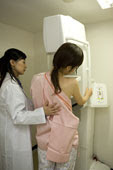 You should be able to find several indispensable facts about in the following paragraphs. If there's at least one fact you didn't know before, imagine the difference it might make.
You should be able to find several indispensable facts about in the following paragraphs. If there's at least one fact you didn't know before, imagine the difference it might make.If your mother had breast cancer, you have an increased chance of developing it yourself. Knowing your family history, understanding your personal risk, getting appropriate screening tests and making lifestyle choices are important steps toward good breast health, according to the Susan G. Komen Breast Cancer Foundation.
"If breast cancer runs in your family, understanding your risk and how to approach your breast health is important to both your physical and emotional well-being," says Cheryl Perkins, M.D., senior clinical advisor for the Komen Foundation.
Increased Risk
If your mother, sister or daughter has breast cancer, your risk of developing the disease is two to three times greater than a woman without this family history. However, being at increased risk for breast cancer does not guarantee you will develop the disease. Talk to your provider to discuss your personal risk and his/her recommendations for regular screening. Regular screening usually includes mammography, clinical breast exams and breast self-exam. Additional screening may be recommended depending on your personal risk.
Gene Mutations and
Genetic Testing
Hopefully the information presented so far has been applicable. You might also want to consider the following:
Only 5 to 10 percent of all breast cancer is due to heredity. Genetic testing can determine if you inherited the mutated BRCA1 or BRCA2 genes, which are key in the development of some breast cancers. However, having a mutated gene does not guarantee that you will get breast cancer. If you have concerns about your family history and personal risk, talk with your doctor about whether genetic testing is right for you.
Taking Preventive Steps-Making Healthy Lifestyle Choices
Many factors can increase a woman's chance of getting breast cancer. While some risks, such as being a woman and getting older, are out of your control, others can be managed. For example, risk factors such as consuming alcohol, lack of exercise and being overweight are all factors that you can modify.
Helping Your Mother Through Breast Cancer
If your mother is diagnosed with breast cancer, she needs your support. From diagnosis through treatment and beyond, your mother's co-survivor network of family and friends will be a vital part of her support system.
As your knowledge about continues to grow, you will begin to see how fits into the overall scheme of things. Knowing how something relates to the rest of the world is important too.























